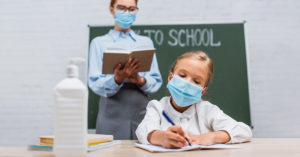
The start of the school year is generally signified by school supply lists and new class schedules. While students and parents are busy purchasing backpacks, notebooks, pens, pencils, and paper, teachers and school administrators are busy decorating bulletin boards, making seating charts, and creating classroom procedures. As schools open or prepare to reopen during the COVID-19 pandemic, additional steps must be taken to protect staff and students from the spread of COVID-19. Whether your school has opted for fully in-person classes or various hybrid options, it’s important to safeguard the classroom for students and staff with PPE for schools.
PPE for Schools
To help prevent the spread of COVID-19, school leaders are being tasked with fundamentally altering how students attend in-person school. Students who are used to working in groups, socializing, and gathering together will now be asked to social distance and work independently. Classrooms, buses, hallways, and extracurricular activities are all being reimagined in ways that can keep staff and students safe.
Masks, face shields, hand sanitizer, antibacterial wipes, no-contact thermometers, and safety signage are all essential for maintaining a safe school environment. These PPE supplies are then paired with behavioral changes, things like limiting group sizes, keeping students six feet apart, closing communal spaces, only using individual supplies, and restricting non-essential visitors. Adapting to these new changes will be an adjustment for students and staff alike, but the process will be easier when you have established procedures and the right PPE essentials on hand.
New School Routines
From morning arrival to afternoon dismissal, keeping students, teachers, and staff safe is at the forefront of every decision facing schools this year. As students return to school,many of their day-to-day routines will have to change. Rather than a stream of students all coming through the front door, high traffic situations, like morning drop-off and afternoon pick-up, will require new school routines that help to minimize crowding.
Staggering arrival and dismissal times, having pick-up and drop-off occur outside, and adding health and safety signage can all work together to limit close contact between students and school staff. Some schools may choose to do a daily symptom screening as part of their drop off routine, utilizing a combination of self-reporting and no-contact thermometers. No-contact thermometers can be used to take temperatures from a safe distance, using an infrared digital thermometer to rapidly read temperatures in Fahrenheit or Celsius using the large, easy-to-read screen. This is a quick and accurate way to determine if students or staff have a fever prior to entering the school.
Once students are inside the school, floor decals can be used to encourage social distancing and indicate traffic flow. These decals can be placed at entrances and exits or anywhere a visual reminder is needed. Floor decals give students a visual target to stand on, helping them with boundaries and distances. Additional mounted or freestanding signs can also help communicate expectations to students, reminding them to wear masks, walk on a certain side of the hallway, or practice social distancing when lining up outside a classroom.
Setting up Classrooms for Success
With desks spaced out, hand sanitizing stations installed, and students and teachers in masks, classrooms will look a lot different as students return. Keeping teachers, staff, and students safe means being prepared and having the right PPE for schools.
To set classrooms up for success, school staff can
- Rearrange desks to maximize the space between students
- Turn desks to face the same direction
- Avoid shared supplies and equipment
- Frequently wipe down high-touch surfaces with an antibacterial wipe
- Use safety signage to indicate traffic flow entering and exiting the classroom, support social distancing, and encourage handwashing
It isn’t just the appearance of the classroom that may look different, classroom routines will be new as well. Inside the classroom, teachers can help students
- Wear their mask, making sure it covers their mouth and nose
- Use hand sanitizer or practice frequent hand washing
- Practice social distancing
- Avoid crowding
As schools reopen, it is essential that they are stocked with the right PPE supplies to keep students and staff feeling safe. For over 60 years, customers have relied on their Safeguard advisor for products, services, and advice. Safeguard is your one-stop-shop for all of your PPE classroom essentials, with PPE products you need in bulk, in stock, in the US, and ready to deliver. Contact your Safeguard advisor or call 855.778.3124 to get started.
Key Takeaways
- Safeguard the classroom for students and staff with PPE for schools.
- As schools reopen during the pandemic, additional steps must be taken to protect staff and students from the spread of COVID-19.
- Masks, face shields, hand sanitizer, antibacterial wipes, no-contact thermometers, and safety signage are all essential for maintaining a safe school environment.
- Safeguard is your one-stop-shop for all of your PPE needs.